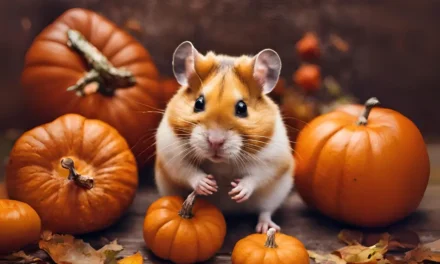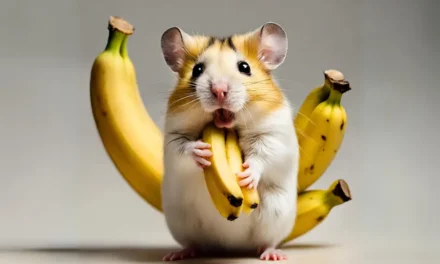As dedicated pet owners, we understand the crucial role of nutrition in the health and well-being of our furry companions, especially our beloved hamsters. Ensuring a balanced diet is essential to promote their vitality and longevity. However, with the vast array of foods available, we often find ourselves questioning which ones are safe for our hamsters to consume. Today, we will explore the safety of grapes for hamsters, providing valuable insights from veterinary experts to guide you in making informed decisions about your hamster’s diet.
Feeding your hamster a well-balanced diet is essential for their overall health and vitality. Typically, a diet comprising high-quality hamster pellets, Timothy hay, and small portions of vegetables, herbs, and fruits suffices to meet their nutritional needs. Occasionally, indulging your furry friend with treats like boiled eggs or mealworms adds a delightful variety to their meals.
However, not all fruits and vegetables are suitable for hamsters. It’s crucial to discern which foods are safe and beneficial for your tiny companion. If you’re contemplating introducing grapes into your hamster’s diet, it’s imperative to ascertain their compatibility and appropriate serving size.
So, can hamsters safely consume grapes? Absolutely! Unlike certain animals for whom grapes pose toxicity risks, hamsters can enjoy this fruit without harm. Nonetheless, it’s essential to note that grapes should be considered a sporadic indulgence rather than a staple in their diet.
Yes, hamsters can eat grapes. However, it’s important to feed them in moderation as an occasional treat due to the high sugar content. Additionally, remove any seeds and ensure the grapes are thoroughly washed to prevent potential choking hazards and pesticide ingestion.
As pet owners, we often wonder if hamsters can eat grapes, considering the toxicity grapes pose to other pets. While evidence suggests hamsters may not experience the same level of toxicity, caution is still advised. Experts recommend offering grapes in small, occasional portions, sliced into manageable pieces to prevent choking. Watch for any adverse reactions and consult a vet if necessary. Overall, while grapes may be safe for hamsters in moderation, it’s best to err on the side of caution.
Note:
As veterinary professionals specializing in small animal care, we understand the importance of providing accurate and reliable information to pet owners. Our goal is to address these questions comprehensively and provide guidance that is both easy to understand and implement.
What Hamsters Can Eat
- Dry Pellets: High-quality hamster pellets provide essential nutrients and should form the foundation of your hamster’s diet.
- Seed Mixture: A balanced seed mix can offer variety and enrichment for your hamster’s diet, but ensure it’s formulated specifically for hamsters.
- Food Blocks: Nutrient-rich food blocks can supplement your hamster’s diet and promote dental health.
- Vegetables:
- Carrots
- Broccoli
- Cauliflower
- Kale
- Cucumbers
- Celery
- Bok Choy
- Parsley
- Turnip greens
- Dandelion greens
- Romaine lettuce
- Protein Sources:
- Eggs (cooked)
- Chicken (cooked)
- Fruits (in moderation):
- Grapes (seedless)
- Apples (seedless)
- Bananas
- Blueberries
What Hamsters Can’t Eat
- Fruit Pits: Avoid feeding fruits with pits, as they pose a choking hazard and may contain harmful compounds.
- Almonds and Peanuts: These nuts are too hard for hamsters to chew and can cause digestive issues.
- Garlic and Onions: These foods can be toxic to hamsters and should be avoided entirely.
- Eggplant: While safe in small amounts, eggplant contains solanine, which can be harmful in large quantities.
- Chocolate and Candy: These sugary treats offer no nutritional value and can lead to obesity and dental problems.
- Bread: Bread lacks essential nutrients and may cause digestive upset in hamsters.
- Alcohol: Alcohol is toxic to hamsters and should never be given to them.
- Tomato Leaves: Tomato leaves contain toxins that can be harmful to hamsters if ingested.
- Kidney Beans: Raw kidney beans contain toxins that are harmful to hamsters.
- Spiced or Seasoned Products: Avoid feeding hamsters foods that are seasoned or contain spices, as these can upset their delicate digestive systems.
Safety of Grapes for Hamsters
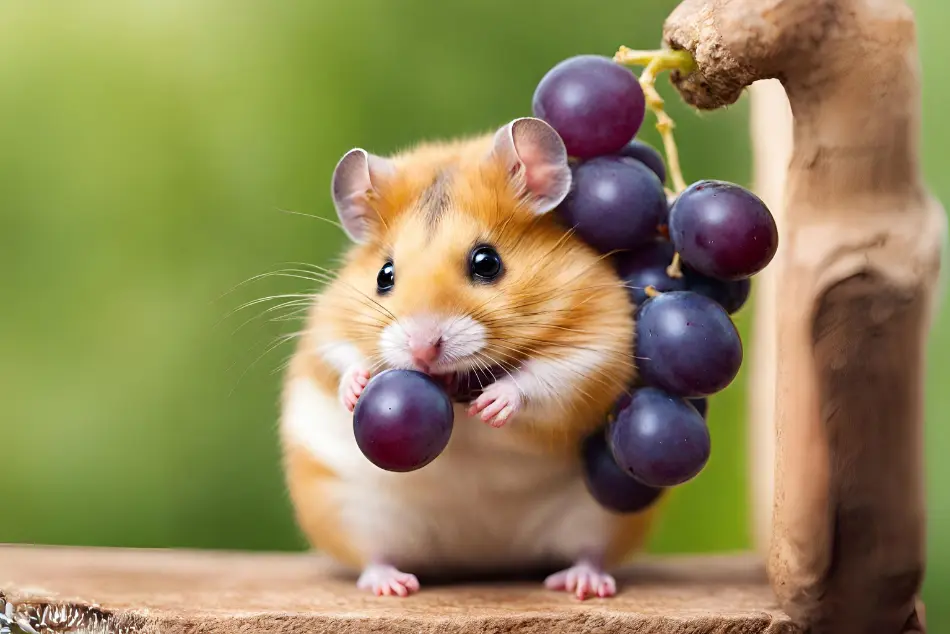
Grapes can be a safe and nutritious snack for hamsters, unlike for cats and dogs. Since hamsters are herbivores, their digestive systems handle fruits like grapes quite well. However, it’s essential to introduce new foods gradually to watch for any allergic reactions. Consulting with a vet can provide further reassurance.
Despite their small size, hamsters only require around 12 milligrams of food per day. Pellets and vegetables should form the bulk of their diet, with fruits like grapes serving as occasional treats due to their high sugar content. Overfeeding fruits can lead to health issues such as fatty liver and diabetes.
There’s no concrete evidence suggesting grapes are harmful to hamsters, but as with any new food, it’s best to start with small amounts. Hamster owners have been offering grapes for years without reported problems, but it’s crucial to monitor for any adverse reactions.
To feed grapes to your hamster safely, offer small pieces and ensure they’re fresh. Remove any seeds or stems to prevent choking hazards. Moderation is key, with grapes being given as treats no more than twice a week to maintain a balanced diet.
How to Properly Feed Hamsters Grapes
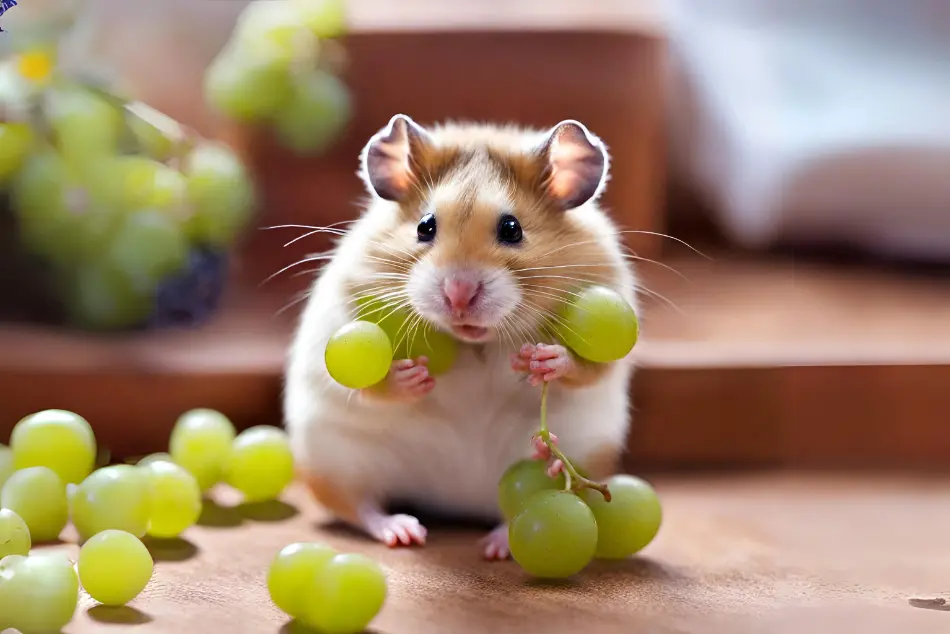
Feeding grapes to hamsters requires caution due to their high sugar content. In the wild, hamsters wouldn’t naturally encounter such sugary treats, so moderation is key. Aim for two to three servings a week, with each serving being a small grape or pieces of one.
Opt for seedless grapes to reduce the risk of choking, and consider peeling them to remove any pesticides. Before incorporating grapes into your hamster’s diet, offer a small test piece to ensure they enjoy it and show no signs of discomfort. Once confirmed, gradually introduce grapes alongside other fruits like pears, bananas, and apples, avoiding citrus fruits.
Alternatively, you can offer dried grapes like sultanas or raisins, but be mindful of their higher sugar content due to water removal. Frozen grapes can also serve as a refreshing treat during hot weather.
Nutritional Value of Grapes for Hamsters (Per 50g):
- Carbohydrates: 3.6g (including 1.7g sugar)
- Protein: 0.7g
- Fat: 0.1g
- Water: 95.23g (per 100g)
- Fiber: 0.5g
- Calories: 15
Concerns for Hamster Health:
- High Water Content: Grapes have a high water content, approximately 95%, which may be too hydrating for hamsters. Excessive water intake, in addition to their regular water consumption, can lead to digestive issues such as diarrhea.
- Low Fiber Content: Compared to other hamster-safe foods like hay, which is high in fiber, grapes lack sufficient fiber with only 0.5g per 50g. This deficiency can contribute to digestive problems and potentially lead to loose stools.
- Inadequate Protein and Fat: Hamsters require a balanced diet with adequate protein and fat. However, grapes provide only 0.7% protein and 0.1% fat per 50g, which may not meet their nutritional needs. Relying solely on grapes for nutrition could lead to deficiencies in these essential nutrients.
Vitamins and Minerals in grapes
Vitamins and Minerals in grapes (per 50g)
The vitamin and mineral content of grapes per 50g can vary slightly depending on factors such as the grape variety and growing conditions. However, here’s a general overview of the vitamins and minerals commonly found in grapes:
Vitamins (per 50g):
- Vitamin C: Approximately 2.1mg
- Vitamin K: Approximately 14.5μg
- Vitamin B6: Approximately 0.04mg
- Vitamin B2 (Riboflavin): Approximately 0.02mg
- Vitamin B1 (Thiamine): Approximately 0.03mg
Minerals (per 50g):
- Potassium: Approximately 89mg
- Copper: Approximately 0.02mg
- Manganese: Approximately 0.04mg
- Iron: Approximately 0.15mg
- Calcium: Approximately 7mg
Problems to Watch Out for When Giving Grapes to Hamsters
Watch out for potential issues when giving grapes to your hamster to ensure their safety. It’s crucial to monitor portion sizes and observe any signs of discomfort or illness. Look out for pica behavior, where your hamster chews on non-food items like bedding, as it could indicate stomach upset. Diarrhea, reduced appetite, and fatigue after eating grapes are also red flags to watch for.
If these symptoms persist for more than a day, it’s advisable to seek veterinary care to ensure your hamster’s well-being.
Nutritional Benefits of grapes to hamsters
- Hydration: Grapes are mainly composed of water, providing some hydration to hamsters, although water remains their primary source of hydration.
- Supplemental Vitamins and Minerals: Grapes contain various vitamins and minerals that could complement a hamster’s diet if they are lacking in certain nutrients.
- Antioxidants: Grapes contain antioxidants, which help in eliminating harmful free radicals and may aid in preventing certain health issues. However, more research is needed to understand how this benefit specifically applies to hamsters.
However, it’s essential to be cautious:
Cons of feeding grapes to hamsters
- High Sugar Content: Grapes are high in sugar, so they should only be given sparingly to prevent health issues like weight gain and diabetes.
- Digestive Concerns: Overfeeding grapes can upset your hamster’s stomach, leading to digestive discomfort.
- Diabetes Risk: Certain hamster breeds, such as dwarfs, are prone to diabetes and should avoid grapes altogether.
How to prepare Grapes to Hamsters?
Preparing grapes for hamsters is relatively simple. Here’s a step-by-step guide:
- Select Fresh Grapes: Choose ripe grapes that are free from mold or any signs of spoilage. Opt for seedless varieties to avoid potential choking hazards for your hamster.
- Wash Thoroughly: Rinse the grapes under cold water to remove any dirt, pesticides, or residues. It’s essential to ensure that the grapes are clean before offering them to your hamster to prevent any potential health issues.
- Remove Stem and Leaves: Carefully remove the stem and any leaves attached to the grapes. These parts can be challenging for hamsters to eat and may pose a choking hazard.
- Cut into Small Pieces: Cut the grapes into small, bite-sized pieces that are suitable for your hamster to consume easily. This step is crucial to prevent choking and facilitate digestion.
- Offer in Moderation: While grapes can be a treat for hamsters, they should be offered in moderation. Too many grapes can upset your hamster’s stomach due to their high sugar content. Limit the portion size to a few small pieces as an occasional treat rather than a regular part of their diet.
- Serve Fresh: Once prepared, serve the grapes immediately to your hamster. Remove any uneaten portions after a few hours to prevent spoilage and keep your hamster’s cage clean.
How many grapes can hamsters eat?
| Hamster Breed | Grape Amount | Frequency |
|---|---|---|
| Syrian | 1 grape per week | Weekly |
| Roborovski | 1/2 grape per week | Weekly |
| Chinese, Campbell’s, | 1/6 grape per month | Occasional Treat |
| & Winter White |
Hamsters should only be given a small portion of grapes, about ¼ of a grape, once per week. These sweet fruits should be seen as occasional treats for them.
Just like how humans should limit their intake of sugary snacks, hamsters should also be careful with fruit consumption. Considering their small size, even a tiny amount of sugar can greatly affect them.
Consuming too much sugar can lead to various health issues in hamsters, including stomach problems, diarrhea, obesity, and even diabetes. It’s essential to monitor their diet to keep them healthy and happy.
Can Hamsters Eat Grapes: Symptoms, Diagnosis, and Treatment
While hamsters can enjoy grapes as an occasional treat, it’s crucial to understand the symptoms, diagnosis, and treatment of any potential issues that may arise from their consumption. Here’s what you need to know to ensure the well-being of your furry friend.
Symptoms:
- Gastrointestinal Distress: Watch for signs of stomach upset, including diarrhea or changes in stool consistency.
- Obesity: Excessive consumption of sugary fruits like grapes can lead to weight gain in hamsters.
- Diabetes: Hamsters are susceptible to diabetes, and a diet high in sugar can exacerbate this condition.
Diagnosis:
- Observation: Monitor your hamster for any unusual behavior or symptoms after eating grapes.
- Veterinary Examination: If you notice concerning symptoms, consult a veterinarian for a thorough examination and diagnosis.
Treatment:
- Dietary Adjustment: Limit or eliminate grapes from your hamster’s diet if they experience adverse reactions.
- Symptomatic Treatment: Your veterinarian may recommend medications or dietary supplements to alleviate symptoms.
- Regular Monitoring: Keep a close eye on your hamster’s health and adjust their diet as necessary to promote overall well-being.
Are Grapes Good for My Hamster?
Grapes can be a tasty treat for hamsters, but it’s important to be cautious about how much you offer them. These fruits are rich in fructose, which hamsters enjoy, but overeating can lead to health issues like low blood sugar, or hypoglycemia. This could make your pet lethargic or, in severe cases, even lead to death. To avoid this, most hamster owners limit grape intake to one or two grapes at a time.
Explore This Article : Can Hamsters Eat Bananas
Are Raisins Good for My Hamster?
Raisins can be given to hamsters, but it’s crucial to offer them in tiny amounts to avoid overfeeding and potential issues like hypoglycemia. While raisins share some nutrients with grapes, they lack the water content and may contain added sugars. Because of this, there are better fruit options available to treat your pet hamster.
Should You Give Grapes To Your Hamster?
You can offer grapes to your hamster as an occasional treat. Hamsters enjoy the sweet taste and squishy texture of grapes, which provide them with additional nutrients.
However, it’s crucial to remember that hamsters have tiny stomachs and require a balanced diet. They need a mix of protein, carbs, fiber, and essential vitamins and minerals in their daily intake, which includes fruits and vegetables.
While grapes can be a part of their diet, moderation is key. Offering them a teaspoon of grapes a maximum of two times per week ensures they get the enjoyment without overloading on sugary treats.
Can Dwarf Hamsters Eat Grapes?
Yes, dwarf hamsters can enjoy grapes as a treat, but it’s essential to introduce them gradually and in small portions, ideally no more than once a week. These adorable pets have cheek pouches, which can sometimes trap grape pieces, potentially leading to injuries or dental issues if not managed properly.
Additionally, dwarf hamsters have a habit of hoarding food, including grapes, for later consumption. However, this can pose a problem if the grapes start to spoil within their hiding spots. It’s crucial to monitor their behavior and promptly remove any hidden grapes to prevent them from rotting and causing health issues.
Chinese Dwarf Hamsters Shouldn’t Eat Grapes
Chinese Dwarf Hamsters should avoid consuming grapes and other sugary foods. This is because they are prone to diabetes, a condition that affects their health. While well-bred Chinese Dwarf Hamsters may have lower chances of developing diabetes, it’s still risky to feed them grapes due to their genetic predisposition toward the disease.
Chinese Dwarf Hamsters, unfortunately, are sometimes utilized in diabetes research due to their susceptibility to the condition. Therefore, it’s essential to provide them with a balanced diet that doesn’t include high-sugar fruits like grapes to maintain their health and well-being.
Can Hamsters Eat All Parts of a Grape?
Hamsters should avoid grape seeds due to the risk of choking and intestinal blockages, which might necessitate surgical intervention. However, they can safely enjoy the flesh and skin of grapes. Opting for seedless grapes is the safest choice, but if using seeded grapes, it’s advisable to cut them into pieces and remove the seeds carefully. This advice comes from veterinary specialists including Tayyaba Arshad, Ali Raza, DVM; Laurie Hess, DVM; and Rick Axelson, DVM.
What Color of Grapes Can Hamsters Eat?
When it comes to feeding grapes to your hamster, any color is fine as long as you remove the seeds first. Grapes are a safe and tasty treat for hamsters, and they can enjoy red, black, or green grapes without any issues.
While red and black grapes contain more antioxidants, which can be beneficial for health, the difference in nutrients between grape colors is minimal for your hamster’s diet. Ultimately, choose the grapes you prefer since your hamster will only eat small amounts, and it won’t significantly impact their nutrition.
Can hamsters eat grapes with skin?
Yes, hamsters can eat grapes with their skin. However, it’s essential to ensure that the grapes are thoroughly washed to remove any pesticides or residues that may be harmful to your pet.
Can hamsters eat grape seeds?
Hamsters can technically eat grape seeds, but it’s recommended to remove them before feeding grapes to your pet. Grape seeds can pose a choking hazard, especially for smaller hamster breeds.
Can hamsters eat green grapes?
Yes, hamsters can eat green grapes. Green grapes are a safe and nutritious option for your pet, but remember to offer them in moderation as a treat rather than a staple food.
Can hamsters eat red seedless grapes?
Yes, hamsters can eat red seedless grapes. Seedless grapes are preferable because they eliminate the risk of choking on seeds. As with other types of grapes, moderation is key.
Do hamsters like grapes and watermelons?
Many hamsters enjoy the taste of grapes and watermelons as occasional treats. However, not all hamsters have the same preferences, so it’s essential to observe your pet’s reaction and monitor their consumption to prevent overindulgence.
Can robo hamsters eat grapes?
Robo hamsters, also known as Roborovski hamsters, can eat grapes in small amounts as part of a balanced diet. However, as with any treat, moderation is crucial to prevent health issues.
Can robo dwarf hamsters eat grapes?
Yes, robo dwarf hamsters can eat grapes in moderation. Like other hamster breeds, it’s essential to offer them grapes as an occasional treat rather than a primary food source to avoid potential health problems associated with excessive sugar intake.

![Can Hamsters Eat Grapes [Answered By Vet Expert]](https://rodentpeteat.com/wp-content/uploads/2024/02/Can-Hamsters-Eat-Grapes.webp)
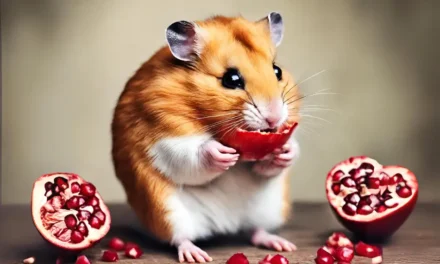
![Can Hamsters Eat Apple [Answered By Expert]](https://rodentpeteat.com/wp-content/uploads/2024/02/Can-Hamsters-Eat-Apple-440x264.webp)
